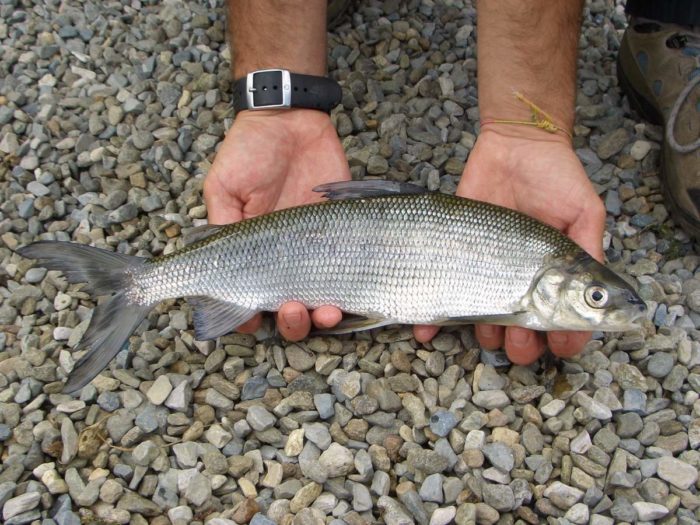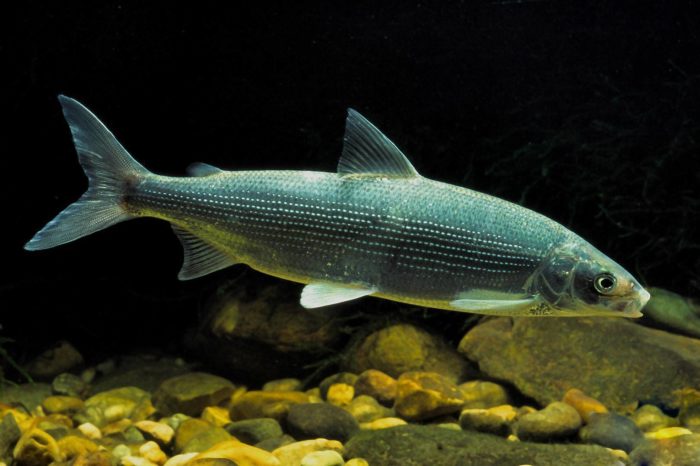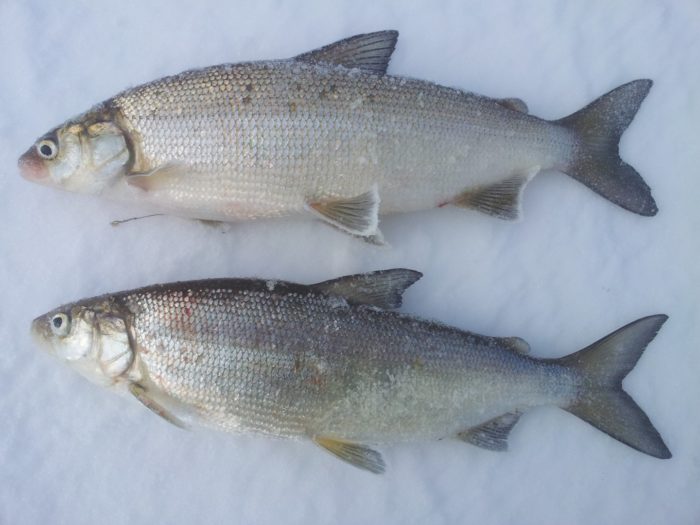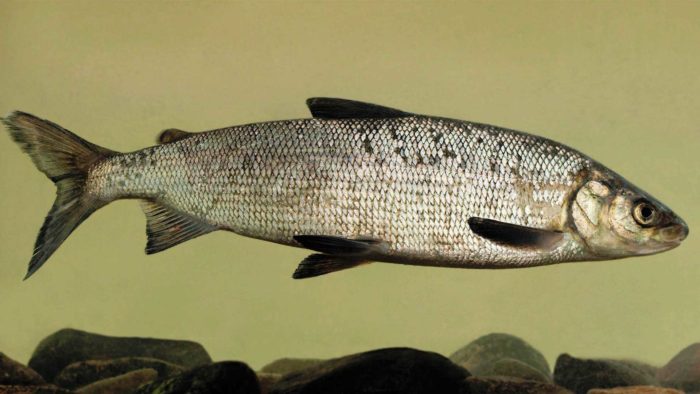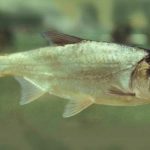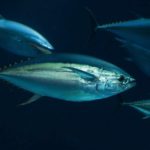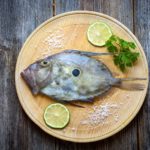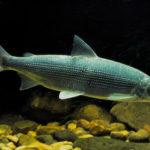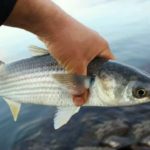Whitefish is one of the most common types of salmon fish. Its value for human health lies in its high content of protein, Omega-3 fatty acids, vitamins and microelements. It is also allowed to grow and breed this fish in a pond at a summer cottage in order to make a profit from its sale. Let's consider the features of this fish, its benefits and possible harmful properties, as well as the features of fishing for whitefish.
Description of whitefish
The different species of these fish (there are more than 60 of them) are difficult to distinguish from each other just by looking at them.They all have a large flat head, a shiny silver body and dark fins. However, not all of them necessarily have spots on their body or fins. Female fish tend to be larger, with larger scales than males. Depending on the environment in which they live, such as temperature and climate, the appearance of each species is slightly different.
Whitefish, although in the same family as red fish such as salmon, has white meat. This fish only has a spine and ribs, which makes it especially sought after.
Appearance
Whitefish have a body covered with tiny scales and flattened on the sides. Its mouth is exceptionally small, and its upper jaw has no teeth. The teeth in other areas of the fish's mouth are usually not very noticeable and soon disappear. This type of fish is quite rare, and some of its subspecies have been listed in the Red Book. Whitefish are prized for their delicious taste.
These cold-water fish can live up to two decades, although catches usually include individuals aged eight to ten years. Depending on the species, their size varies from 9-16 cm for small ones to 45-65 cm for large ones. The average weight of caught specimens is approximately one kilogram, but some large specimens can weigh up to twelve.
Habitat
Whitefish is a commercially important species and has been introduced into many water bodies in Russia and the former Soviet Union. It is regularly caught from the Gulf of Finland, the waters of Onega and other lakes. On the Kola Peninsula it thrives in large bodies of water.
Whitefish usually live in rivers, but they can also be found in seas and lakes, especially in winter when the temperature drops. These species are predominantly found in cold or temperate climates located in the northern hemisphere.
Whitefish are bottom dwellers and swell greatly when netted from great depths, like other fish that live at such depths. They are known for their migratory habits, meaning they travel from seas to rivers to breed. They have adapted to live in both salt and freshwater environments.
Useful and harmful properties
Whitefish are beneficial in many ways. It is full of vitamins and healthy fats that can help regulate the functioning of internal organs. Unlike animal fats, it does not pose any health risks and is especially beneficial for people with digestive problems due to its ease of digestion.
Whitefish are used in cooking, cosmetology and medicine. Fish is especially useful for women who are trying to conceive a child, as it contains folic acid. Regular consumption of fish will provide the body with vital nutrients necessary for a successful pregnancy, and will also allow a woman to look great even during this period.
Medical professionals and nutritionists advise limiting whitefish consumption for people who have any of the following conditions:
- high blood pressure;
- inflammation of the stomach;
- problems with the thyroid gland;
- tuberculosis;
- venous obstruction;
- inflamed and irritated mucous membranes in the large intestine;
- phlebeurysm.
People with nervous system disorders benefit from eating fish, as it is a good source of iodine, which has a positive effect on the endocrine system.
100 grams of whitefish fillet contains about 19 grams of protein, 12 grams of fat and 0 grams of carbohydrates. It also contains about 400 mg of potassium, 250 mg of phosphorus, 150 mg of sodium and 2 mg of iron. Whitefish is a good source of vitamins B12 and D. It also contains Omega-3 fatty acids, which improve the functioning of the cardiovascular system, reducing cholesterol levels and the risk of developing diseases.
However, those who have allergies or intolerance to seafood should avoid whitefish, as the fish can be harmful to their health. In addition, you should not eat lightly salted or smoked carcasses, as there is a risk of infection with parasites.
It is also worth considering that whitefish contains some harmful substances, such as methylmercury, which can accumulate in the body and cause serious health problems. Therefore, when consuming whitefish, it is necessary to take precautions and not consume it too often.
Varieties
Whitefish have specific habitat requirements, including clean, cool water. There are several varieties that are not found everywhere.
- Muksun has a pale pink flesh color and is a semi-anadromous freshwater fish that migrates to spawn. Found in the Arctic Ocean.
- Nelma also lives in northern waters, but is protected by the laws of the Red Book of the Russian Federation, which prohibit their catching, keeping and transportation.
- There are two subspecies of omul: the Arctic omul lives in rivers such as the Pechora, Yenisei and Lena, and the Baikal omul lives in the waters flowing from the Arctic Ocean.
- Peled is a lake and river fish that is of interest for industrial production due to its valuable properties.
- European vendace is a species of whitefish commonly found in Baltic waters.
- Siberian vendace, also known as ripus, is a small fish that lives in freshwater bodies.
- Anadromous species are distinguished by their large hooked snout and lower position of the mouth, which distinguishes them from other species.
- The Ussuri is found primarily in the Amur River and the southern part of the Sea of Okhotsk.
- Valek lives in rivers from the Yenisei to Chukotka, as well as from Alaska along the entire coast of North America.
- Tugun is found only in Siberia.
- Chir prefers freshwater rivers located beyond the Arctic Circle.
Reproduction
Whitefish is a type of predatory fish that is naturally wary, so it won’t just bite a hook. Depending on the body of water, whitefish are classified as coastal, deep-sea or pelagic species. They typically feed on the eggs of other fish and their own species, as well as a variety of insects, crustaceans, mollusks and larvae. In addition, they do not miss a single opportunity to feast on fry, juveniles, smelt and other small fish.
Whitefish spawning occurs in November, usually among shallows covered with reeds and reeds. This activity continues until March. Once the eggs hatch, the larvae feed on biological dust.
The peculiarity of whitefish spawning is that it occurs in cool waters. The ideal water temperature for whitefish spawning is from 2 to 5 degrees Celsius. The female lays 500 to 1500 eggs over several days, while the male fertilizes them within 2-3 days. The fertilized eggs then settle on pebbles or gravel at the river bottom, where they develop until the fry hatch.
Depending on where they choose to spawn, whitefish are divided into three types:
- River whitefish that usually remain in their home river but are capable of moving upriver.
- Lake fish that remain within the same lake.
- Lake-river whitefish, which live primarily in lakes but migrate upriver to breed.
In Russia, whitefish are found both in lakes and seas. One of the benefits of living in salt water is that whitefish gain a lot of weight because freshwater bodies lack nutrients. Consequently, female whitefish migrate from one place to another during spawning, swimming up rivers leading to the seas.
Tips for fishermen
Fishing for whitefish is prohibited during the spawning period, and fishing for nelma and European grayling is completely prohibited due to their inclusion in the Red Book. However, when not prohibited, fishermen usually begin fishing immediately after the thaw. The main bait used for catching whitefish is a modernized version of the jig.
When May rolls around, anglers should start looking for whitefish as they tend to feed on grayling eggs during their spawning season. The most suitable gear for this time of year will be gear that takes this fact into account, that is, the ideal bait will be caviar or a bait that imitates caviar.
People who are well versed in the art of fishing know which gear is best for catching whitefish and choose the most suitable option.
- Float fishing is a popular method used to catch predatory whitefish. This technique is especially effective in the spring season when fish are hungrier than usual after winter and will take almost any bait, including worms.To do this, fishermen use a medium telescopic rod, the length of which reaches five meters, with a special fishing line for large fish or a braided fishing line no thicker than 0.3 mm. In addition, the kit should include a small float, the color of which should be chosen carefully so as not to scare away the fish. The size of the hook should also correspond to the size of the fish that are found in that particular body of water.
- Fly fishing is a great way to catch whitefish in both winter and summer. You should use a rod up to sixty centimeters long and weighing up to fifteen grams, the fishing line is attached to the tip. At a distance of 25-35 centimeters from the fishing line, two nymphs should be attached, either by tying them with red yarn, or by purchasing pre-made ones. To accurately determine where whitefish are located in the water column, having a fish finder is essential to success - otherwise it will be too difficult to succeed in fishing. If you are lucky, you will be able to mark the depth and fish from this depth - usually you first lower the bait to the bottom, and then gradually raise it higher, since whitefish are found at any depth.
- With spinning rod. Fishing for whitefish using jigs is said to be an enjoyable experience. To do this, you will need to use a strong rod, reel and high-quality braided fishing line. It is suggested to use pike perch silicones or deep-sea baits as bait, since whitefish have a small mouth and are not able to swallow bulky objects. Lures that work best are those that are smaller in size and have a smooth shape. It has been noted that whitefish usually bite on light-colored baits or baits of bright colors; however, it is recommended that you experiment with different lure colors to see which attracts you the most.
- Rod fishing is a suitable method to use when fishing during the late fall months. During this time, whitefish often move close to the shoreline, requiring a strong rod and reel with a higher gear ratio. It is also important to have a sinker on hand. The bait for this technique is usually maggots, used to catch whitefish from the bottom of the reservoir. This type of fishing requires moving baits that do not stop moving. Artificial red lures are typically used when fishing deep waters such as holes where whitefish can be found this time of year.
About winter fishing
Whitefish spawn before lakes and rivers freeze, making them impossible to catch during this time. Anglers should also be aware of the potential danger that awaits them due to the unevenness of the first layer of ice on fast-flowing rivers. The fish become active in mid-January, so fishing is ideal during this time, called "last ice." Whitefish can be found in holes under riffles or other deep areas of the reservoir. They are caught with fishing rods with balancers and flies; large jigs of red or dark shades will also work.
When using bottom rigs, baits such as invertebrate imitations, fish fry and eggs of other species are regularly used. Worms, invertebrates and shellfish meat are the preferred choice when fishing for whitefish, as they form part of its diet. Fishing with a fly that imitates small insects and jigs of different sizes is also effective.
Is it possible to grow whitefish?
There are different approaches to breeding fish of the family salmonids, which depend on the type of fish and its nutritional needs.
- The extensive system does not require special pond food and uses food already present in the pond.This approach is well suited to southern regions and large reservoirs where whitefish are raised in combination with other herbivorous species due to the abundant natural food supply.
- Semi-intensive breeding requires protein supplementation as well as energy sources such as carbohydrates, which are provided by natural feed or supplements.
- Finally, intensive culture systems involve the reclamation of ponds and the introduction of artificial feeds and fertilizers to create a suitable diet for the fish.

